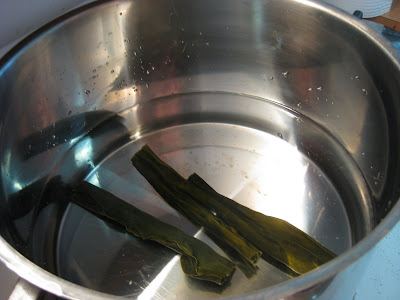
Mmmm, tasty looking photo, isn't it?
Firstly, my apologies for the lack of posts over the last week and a bit. Life seems to have gotten away from me. To make up for it, I cordially invite you to join me on my journey into the world of
Momofuku.
I first took notice of David Chang and Momofuku over at
Almost Bourdain, when Ellie made the
crack pie from
Momofuku Milk Bar. In her post, Ellie links to a number of articles discussing the (many) merits of the crack pie. One of these was a video of Martha Stewart visiting Momofuku Milk Bar and talking with David Chang and Christina Tosi. Apart from making me want to take the next flight to New York so I could spend mass amounts of money at Milk Bar, the video also made me realise I had seen
David Chang on the Martha Stewart Show before, making his
steamed pork buns and I'd bookmarked them to try later.
All of these things came together and I realised that I wanted to know more about Chang and his fabulous fusion. I read through the archives of
Momofuku for Two, where Steph and her gorgeous kitchen beakers are cooking their way through the
Momofuku cookbook. I googled. Extensively. I found gems such as
this list from
Grub Street New York of the 10 Things Anthony Bourdain and David Chang Hate. It all just increased my curiousity and I decided I had to buy the cookbook.
Plus, one of my favourite characters from
Avatar: The Last Airbender is
Momo. And
Appa. What, not relevant? Okay then.
Of course, the cookbook took ages to arrive but that did just sweeten the anticipation. It's a fantastic read. I love cookbooks that can be read like a story, or include stories. It gives a real insight into the chef and makes the book all the more enjoyable. I carried the book around with me everywhere like a little kid with a favourite toy for an embarrassingly long time. I made lists, which admittedly were only the poor man's version of the
ultimate of Momofuku lists made by Steph at Momofuku for Two.
It took me a little while to move from voraciously reading everything Momofuku-related that I could find to actually trying some of the recipes for myself. D doesn't like pork, which means that a number of Chang's recipes would not be well received by him. He is also a little picky with his flavours, so I wasn't sure how some of the more Asian influenced ingredients would go down with him. In the end, I decided to start slow and simple with the Momofuku bacon dashi.
Chang created bacon dashi when he couldn't find any katsuo-bushi he was happy with. He thought that using a good bacon would give a similar smoky flavour as if you were using the katsuo-bushi without the fishiness. It is one of the simplest recipes in the book with only three ingredients but it does require you to hunt down some really good quality smoky bacon. I had and still have absolutely no idea where to get good quality smoky bacon from around here and I think that my choice to use supermarket bacon was the main reason that I didn't find the bacon dashi to be the wonder Chang says it is.
My bacon dashi was quite bland and needed an awful lot of seasoning. Even then, it didn't really work for me.
Does anyone have any suggestions as to where I can get some nice smoky bacon in Brisbane? I'd really like to make this again.
























